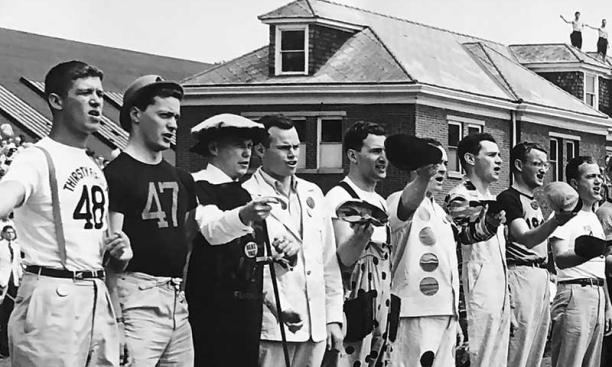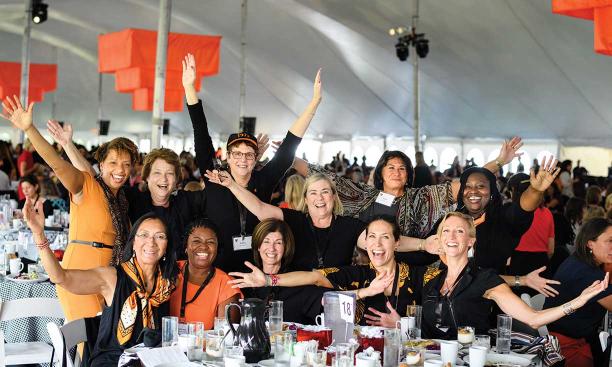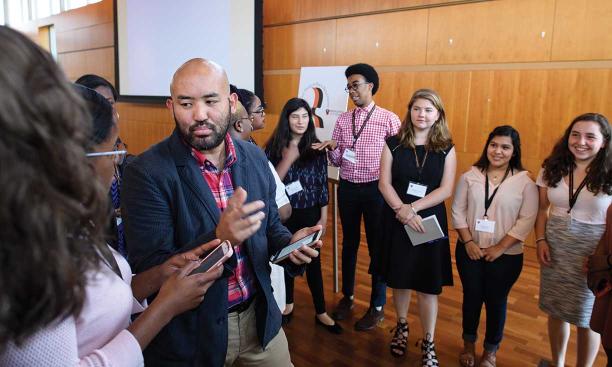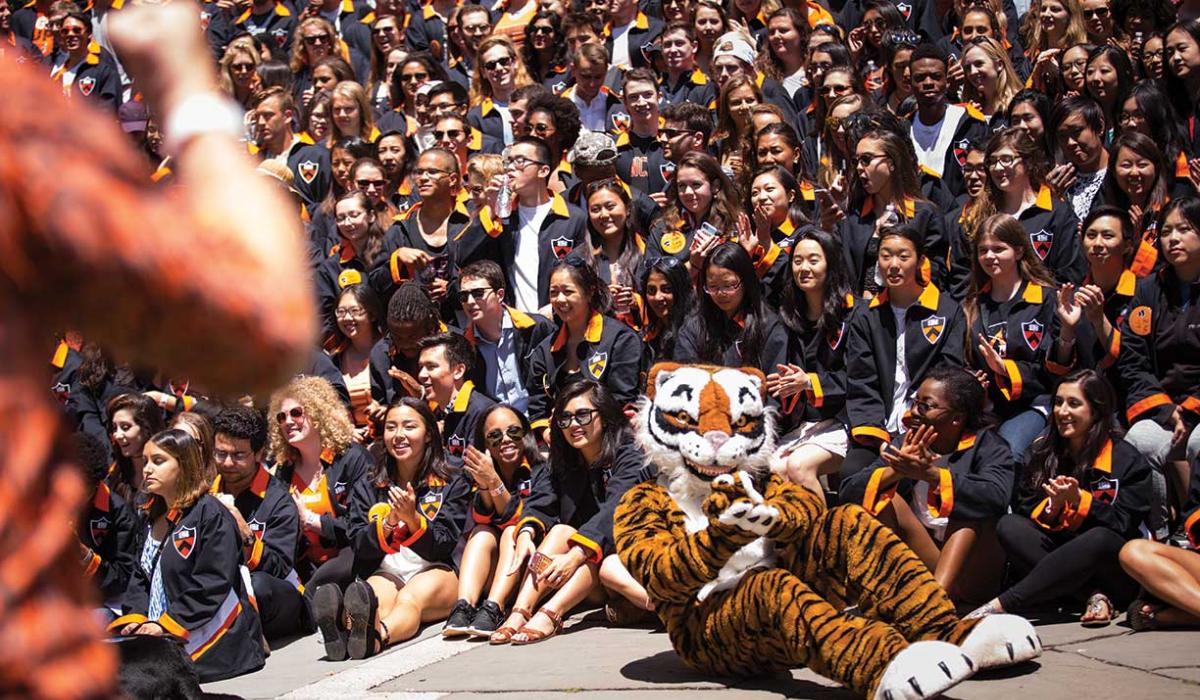Some call it the “special sauce”; others, “our secret weapon.” They are referring to the fanatical loyalty Princeton’s alumni feel for their university. To many who have earned their degrees here, Princeton will always be “the best damn place of all.”

That line, of course (though the University now omits the expletive), comes from Princeton’s favorite fight song, “Going Back to Nassau Hall,” which celebrates returning to campus, something tens of thousands of alumni did weeks ago for the first in-person Reunions since 2019. As every Tiger knows, there is never an off year. For some, there is barely even an off week.
To get the flavor of Princeton’s secret sauce, spend some time with Jocelyn Goldberg-Schaible ’74, who has been giving back as well as going back for nearly half a century. Just recently, she attended the Princeton Today and Tomorrow Leadership Conference, which paired alumni from her own class and their “child” class of 1999. She also helped organize a Zoom conference that matched medical professionals from ’74 with pre-meds in their “grandchild” class of 2024.
As Goldberg-Schaible exemplifies, being a Princetonian is not just a four-year experience. “You’re in it for life,” she says, “and that family stays as connected as you want it to be.”
“Our Ivy peers are always trying to learn from us,” says Jennifer Daniels ’93, who chaired the Alumni Council from 2017 to 2019 and has served in a host of other capacities, including class officer, Annual Giving participation chair, and head of the Princeton Schools Committee. “At Princeton, we’ve always been open to ideas coming up from alumni and trying to support them, trying to engage in conversation rather than having a top-down approach. That has allowed for some incredible inspiration and innovation, which has, in turn, provided new and meaningful ways for alumni to feel connected to Princeton.”
There has been, most agree, a “Princeton Way” of engaging with alumni that is unique among American universities. “It has been a partnership,” explains Henry Von Kohorn ’66, a former Alumni Council and Schools Committee chair and founder of the Princeton Prize. “Alumni really do have some say in what goes on, and that has played out in a lot of ways, in terms of people working harder, being more loyal, and generating initiatives that wouldn’t get started at other universities.”
Yet there have been rumblings of discontent over the last several years, sometimes hard to pin down yet distinctly audible. Numerous alumni have expressed concern that the University has become more “corporate” or “bureaucratic” or “lawyerly” as it has gotten larger, that it has become less responsive to alumni and less interested in what they have to say, that alumni are no longer entrusted with the same level of responsibility, and that engagement is taking more of a back seat to big-dollar fundraising.
By many measures, alumni support has never been healthier. Annual Giving brought in more than $68.6 million last year, helping to boost the endowment to a whopping $37.7 billion, and a higher percentage of Princeton’s alumni give back to their alma mater than graduates of any other college. Still, the Annual Giving campaign, which boasted 61.4-percent participation as recently as 2013-14, drew contributions from only 49.6 percent last year. Participation rates by some younger classes are even lower.
Is something going on? In preparing this article, PAW spoke to more than two dozen alums from a wide range of graduating classes and backgrounds to get their views on the University’s relationship with its alumni and how that may be changing. Many spoke on the record, but others asked that their names not be used. Not all were critical. Almost all, in fact, praise many aspects of the University, but they are anxious to ensure that the same close relationship they have enjoyed with Princeton is passed down to future generations.
“At Princeton, we’ve always been open to ideas coming up from alumni and trying to support them, trying to engage in conversation rather than having a top-down approach. That has allowed for some incredible inspiration and innovation, which has, in turn, provided new and meaningful ways for alumni to feel connected to Princeton.” —Jennifer Daniels ’93 Alumni Council chair 2017-19
One thing upon which everyone agrees is that being a Princetonian should be a lifelong journey. That sentiment starts at the top.
“Our alumni and the special relationship Princeton has with them are the not-so-secret weapon of this university because it is the envy of just about all others,” says President Chris Eisgruber ’83. “That is one of the great advantages that we have, and a distinctive part of our identity.” Another alum, Deputy Vice President for Alumni Engagement Alexandra Day ’02, echoes Eisgruber’s views.
The vehicles for that lifetime journey are the Alumni Association, to which all alumni belong, and its governing body, the Alumni Council. They offer graduates a wide range of ways to stay connected. Among many other undertakings, the Alumni Council plans Reunions and Alumni Day and has worked closely with the administration in designing affinity conferences that have brought thousands of female, Black, Latino, Jewish, Asian and Asian-American, LGBTQ, and graduate alums back to campus.
“Princeton serves as a really powerful source of community and connection,” says Mary Newburn ’97, the current Alumni Council chair. “I’ve continued to be impressed by the ways the University seeks to engage alumni.”
Broadly speaking, alumni connect with Princeton in two ways: by giving their time and by giving their money. For many years, Princeton took pride in the fact that those pursuits — engagement and fundraising — were separate. The message that separation conveyed, numerous alums explain, was that alumni are valued for their time, labor, and participation, regardless of the size of their donations. Hence the emphasis, drummed into countless Annual Giving calls by classmates to classmates, that giving something, even a few dollars, still matters.
Princeton was among the first colleges in the country to have an alumni organization. An entity known as the Alumni Association of Nassau Hall was founded in 1826, with former president James Madison 1771 as its head. After the Civil War, regional clubs began popping up and alumni began to support specific activities on campus, such as the football team, the Triangle Club, and the Nassau Literary Magazine. Throughout the first half of the 20th century, alumni organizations became more formal, leading to what are now the Alumni Association and the Alumni Council.
Fundraising took a different path. Done on an ad hoc basis through much of Princeton’s history, when the first Annual Giving campaign was launched in 1940, fundraising was separated from the Alumni Council and later placed in the development office, which was created in 1956. When the first vice presidents for development and public affairs were appointed in 1969 and 1970, respectively, the development office reported to the former and the Alumni Council to the latter, as a way of giving senior-level attention to both.
In 2002, the executive committee of the Alumni Council and the Trustee Committee on Alumni Affairs issued a joint statement reaffirming the importance of alumni engagement. “One of Princeton’s historic strengths,” it said, “has been its assurance to alumni that their participation in the life of the University is valued no matter what form it takes … .” The statement went on to express the “expectation that alumni will be active participants in the life of the University, with real responsibilities for designing and delivering many of the programs in which alumni are involved … .”

That statement was incorporated into a self-study by the Office of Alumni Affairs in 2015, and in a statement endorsing its findings, Eisgruber “reaffirmed that Princeton, unlike some other universities, should have distinct and independent offices devoted to alumni affairs and development. That distinction is important to our model of alumni engagement … .” Eisgruber also announced that, going forward, both offices would report to the newly created position of vice president for advancement. However, after the advancement office was created in 2016, many responsibilities of the alumni affairs office were distributed within an overarching structure focused primarily on fundraising. This change in Princeton’s approach to alumni relations was not communicated or explained to the alumni, several alums say.
Eisgruber believes that it makes sense to bring engagement and development under the umbrella of advancement to prevent the “silo-ing” of departments that he calls “the enemy of getting things done” in a large organization. Most alums give time as well as money, and some activities, such as Annual Giving solicitations, combine both, so there is little reason to separate them, the reasoning goes. In the same way, the Board of Trustees recently merged its long-standing Committee on Alumni Affairs into a new Committee on Advancement. Some alumni, however, worry that in a single committee, there will be a tendency for the trustees to devote more attention to fundraising than to other forms of engagement.
Many programs remain initiated or driven by alumni. But several other activities have changed in different ways. The Alumni Schools Committee, for example, which seeks to offer every undergraduate applicant a personal interview with a Princeton alum, has more than 7,200 alumni volunteers. In recent years, the admissions office has expanded a written guidebook of dos and don’ts and, starting last year, required all alumni interviewers to watch an interactive training video. Some of the changes, such as a rule that interviews no longer be held in an alum’s home, are driven by legal concerns, say those who have served on the committee, while others, such as a rule that requires alums to take a break from interviewing if they have a child applying to college that year, are meant to avoid the appearance of a conflict of interest.
Of greater concern, say alums who spoke with PAW, is the fear that alumni affairs no longer has a “distinct and independent” identity. As evidence, they point to several changes made in recent years. On one hand, the Alumni Council’s staff has grown substantially, but many have moved from Maclean House, long styled as the home for alumni on campus, to the Overlook Center on Route 1. The advancement office now handles communications for both engagement and development, which promotes synergy but has raised concerns that engagement is getting shortchanged as the University pursues the massive Venture Forward capital campaign. Despite rumors that the University would stop offering the hugely popular affinity conferences, Eisgruber and Day say the conferences “absolutely” will return post-COVID, but that a trustee committee is evaluating how to structure them, including their size, scope, and frequency.
Hand in hand are concerns that Princeton is no longer as committed as it once was to the expectation — as expressed in the University’s 2002 statement — that alumni will have major responsibilities for designing and delivering programs.
There might be no better example of such a program than the Princeton Prize in Race Relations. The program was founded in 2003 to celebrate high school students working for racial equity in their communities, regardless of whether they are applying to Princeton. The University initially permitted the use of its name, offered staff support, and later financial support, as well. Senior University officials also serve on its board. From two pilot programs in Boston and Washington, D.C., the prize now operates in 29 regions nationally, with more than 400 alumni volunteers. Each region awards a $1,000 prize and multiple certificates of accomplishment, and students who receive the prize are invited to campus for a Symposium on Race Relations.
The prize is intended to reward and motivate students to continue their work for racial equity in college and beyond. Since its inception, the administration has supported it but has relied on alumni volunteers to develop policies and practices, select winners, and honor them in their communities.
Early in 2020, however, the prize’s alumni board received notice that Princeton was reevaluating its ties with the prize and several other alumni-run programs. After a brief review, and without consultation, say prize board members, a consultant hired by the University recommended that the prize be restructured so that regional alumni have a much less substantive role, passing operational control to Princeton. The University, in turn, would be advised by a much smaller alumni board. After widespread objections, that plan was dropped, and a new consultant has been hired to assess the prize’s impact and consider how alumni and the University might work together.
What distinguishes the Princeton Prize from many other alumni-run programs, Eisgruber says, is the level of University funding and support it receives. “It’s one thing if alumni are running a project and come together in the great tradition of volunteerism … and do things that carry forward the mission of Princeton in their own communities,” the president says. “There are other circumstances where alumni are organizing something using the Princeton name and then also seeking a lot of staff assistance around that.”
The Princeton Prize, he believes, “is [no longer] just an alumni project. We have to make sure that staff are engaged in the right way.” Related to that are legal and regulatory concerns. Projects such as the prize “are subject to a level of scrutiny [and] compliance risk that we have to be attentive to,” Eisgruber adds, “particularly if what you’re talking about is something that is a joint project involving University staff and running in the University name.”

Princeton’s role in other alumni activities also has been growing. Eisgruber cites Princeton Internships in Civic Service (PICS), a service project founded by the Class of ’69 following its 25th reunion. After running the program from its inception, the class has turned PICS over to the University, where it is now part of the Pace Center for Civic Engagement. Alumni, however, continue to play an important role identifying internships and mentoring students, and an alumni advisory council provides operational support. Last year, the University also assumed responsibility for PAW’s budget, eliminating the burdensome subscription bills paid by classes. It signed an agreement with PAW’s advisory board — to be reviewed periodically –— committing to PAW’s continued editorial independence.
“No, I don’t think everything has to be under a University administrative umbrella,” Eisgruber insists. “Princetonians can come together in lots of different ways.” However, he continues, “If somebody brings a project to us and says we want you and your staff, the central administration of the University, to run this project, then we do have a responsibility to make sure that we’re running it according to the set of principles that define who we are, that are consistent with the ethical obligations that we have to the world, and that are consistent with our legal obligations. But not every operation has to be brought to us in that way.”
If some alums sense that the University has become more bureaucratic, that’s because it has. Princeton is much bigger than it was a decade ago and is getting even bigger. The size of the student body has grown. Two new residential colleges and numerous academic buildings are being constructed, along with a huge expansion of the art museum. Programs have been added to provide more services to students — such as more mental-health counseling and support for first-generation students — and to reflect shifting priorities, such as a greater emphasis on diversity and inclusion.
Such expansion requires more structure, more rules, and especially more staff. In fall 2021, Princeton reported about 7,300 benefits-eligible employees, an increase of about 22 percent since the fall of 2012. According to statistics in the Common Data Set provided by the University registrar, the number of faculty members grew by about 8.5 percent during that period. It all adds up, and more so at Princeton than almost anywhere else. Absolute numbers are hard to come by, but a 2018 study by The Chronicle of Higher Education found that Princeton had the second-highest ratio of full-time “managers” to students in the Ivy League, and the seventh-highest ratio of any four-year private college in the country. (“Managers,” as defined by the Bureau of Labor Statistics, includes everyone from department administrators to facilities managers to Eisgruber himself.)
Add to that the recognition that we live in a more litigious society, one in which the University can not only be sued for the acts of a misbehaving alum engaged in an alumni project but also be brought up on charges in the much wilder court of social media and public opinion. It is, then, perhaps not surprising that a greater emphasis is being placed on ensuring that there are rules and structures for activities that were once informal. The question, some alumni ask, is whether the administration still trusts them enough to continue giving them substantive responsibilities.
Two alums from different generations offer interesting perspectives. Scott Magargee ’62 says that the Alumni Council, which he once chaired, has grown from being a “mom and pop” operation into something much bigger — but also better. “It can’t be like the old days,” he says. “The University simply can’t be as responsive to the alumni as it used to be because it’s so much more multifaceted now.”
Eric Plummer ’10, president of the Association of Black Princeton Alumni, notes that ABPA has grown tremendously since its founding in 1972. In addition to serving as a vehicle for Black alumni to connect with each other and with the University, it honors alumni, students, and staff for their contributions to the Princeton community. The group has worked with the Alumni Council, of which it is a part, to plan four highly successful and well-attended affinity conferences. ABPA members now regularly serve as advisers and sounding boards for the administration on a number of other campus issues, as well.
“Fifty years ago,” Plummer laughs, “we basically had Carl Fields [Princeton’s first Black administrator], and that was it. OK, we had complete autonomy, but now we have access to the full resources of the University.” That means there is more money available and more staff support, but also more rules, structure, and people who have to sign off on things. “You can evaluate whether that’s good or bad,” Plummer says, “but it has made it a much lighter lift for us to go bigger.”
With his background as managing director of Silicon Valley Bank, Plummer offers a different analogy to describe the modern University’s relationship with its alumni. Rather than being a “mom and pop” operation, he likens the University of today to a venture capitalist. “They provide critical support that helps us grow,” he says, “but they also want a seat on the board. And they set expectations.”
You may have heard this old joke: How many Princeton alums does it take to change a light bulb? Answer: Four. One to change the bulb and three to complain about how much better the old bulb was. Is that what’s going on here? The alumni PAW spoke to vigorously dispute it.
“Do I think we’re becoming grumpy old men?” Von Kohorn asks. “I don’t. I’m a glass-half-full kind of guy. I love the new Princeton and the current makeup of the student body. Yet, with all the changes, the younger classes still appreciate the Princeton culture of alumni involvement.” Even so, he and others believe that something ineffable has changed, something that long made Princeton unique. “I wonder whether a new initiative like the Princeton Prize in Race Relations could happen today.”
Several alums told PAW they feel that, as a statement about alumni loyalty to the University, it is important to get the Annual Giving participation rate back to where it used to be. Y.S. Chi ’83, a former trustee, observes, “The largest gifts often come from people you don’t foresee. You risk losing that if you don’t get everyone accustomed to giving every year and focus too much on the nine-digit gifts. However, I believe the University and the alumni volunteers agree about this.”
A shift in focus might also be counterproductive in ways the University does not intend. “For those alums, like myself, who do not come from familial wealth, the way we give back to Princeton is through our time, not the size of our donations,” says Arati Johnston ’84, who recently completed two terms as board chair of the Princeton Prize. “The University needs to make sure that its commitment to diversity and inclusion extends to its graduates. It’s harder for people to feel engaged if they perceive that what they can give is less valued.”
The Princeton of 2022 is not the same as the Princeton of 2002. Or 1952. Or 1902. Throughout the University’s history, its relationship with the alumni has changed as Princeton has changed. “We benefit tremendously from the kind of engagement that our alumni bring to lots of aspects of the University,” Eisgruber says. “We remain faithful to those values and to that tradition. … So, with this, like everything that we do, it’s about simultaneously [showing] fidelity to the values that define us and the identity that makes Princeton special, and a recognition that as the world changes and as our alumni body changes, we have to think creatively and imaginatively about how we sustain those commitments.”
Daniels believes that concerns raised by alumni stem from a belief that “both Princeton and its alumni have, for generations, benefitted from their strong partnership. The question is, how can we maintain and enhance that ‘secret sauce’ going forward in ways that feel meaningful and bolster the alumni’s connection to the University and to each other?”
“No one told us to do what we do,” Goldberg-Schaible says of the many roles she and so many other alums play supporting the University. “We just do it because we’re part of Princeton.”
Mark F. Bernstein ’83 is PAW’s senior writer.



